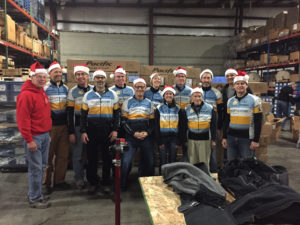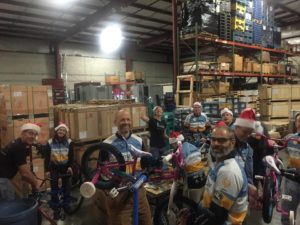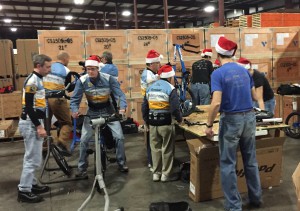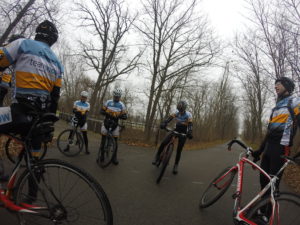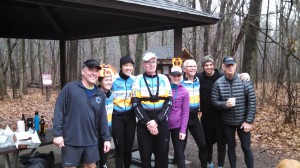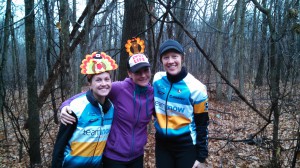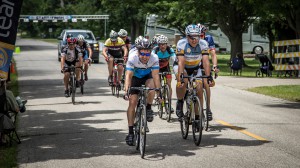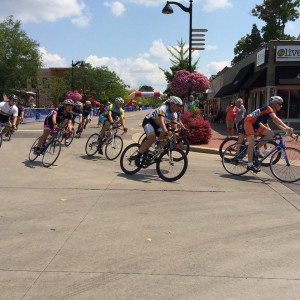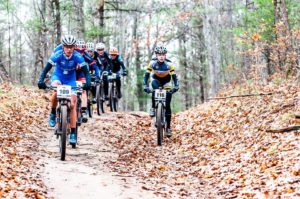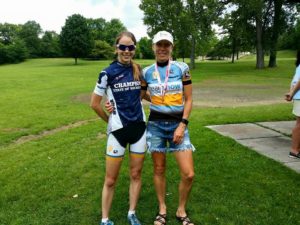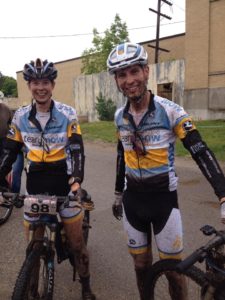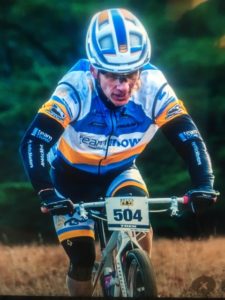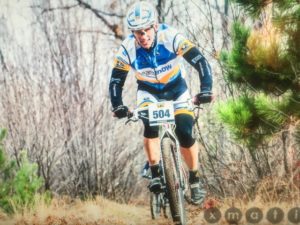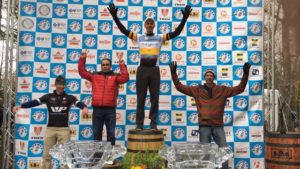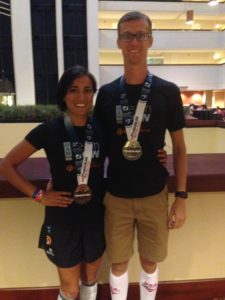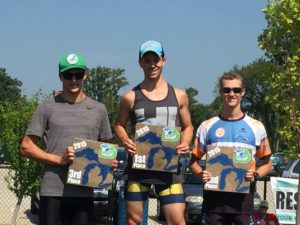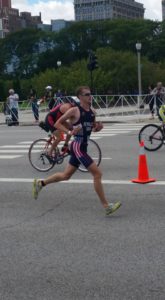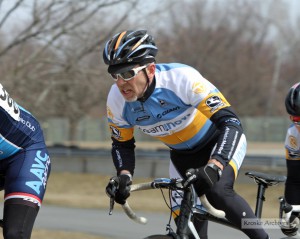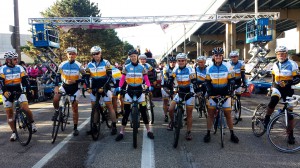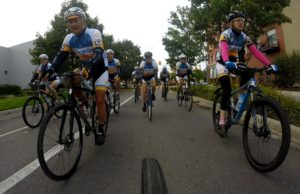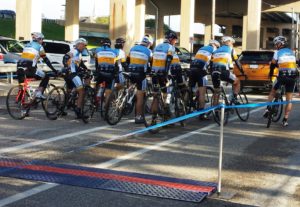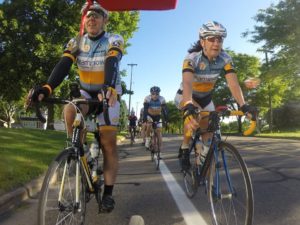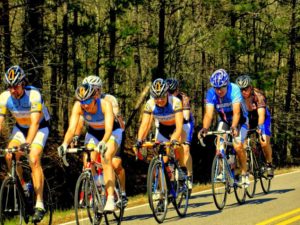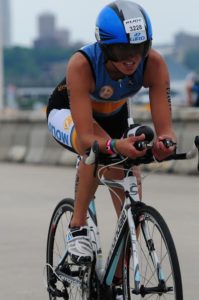 When I first started becoming serious about endurance sports a few years ago, several cyclists I rode with on Tuesday nights mentioned using Strava. I really had no idea how it worked. For me, training consisted of swimming, cycling, and running basically whenever I felt like it, and mixing in body weight workouts and yoga to keep everything fresh. When other athletes suggested I make an account and upload my workouts, “Not for me,” I replied. “I have limited data and I use Apple Maps so I won’t get lost. I have it on my little wireless cateye computer and I pop it into my excel spreadsheet so I can make sure I’m biking enough.”
That was the attitude I had until I began veterinary school at Michigan State University. There, I met some intense triathletes who really encouraged me to get Strava. “We have an MSU Tri Club Strava group! We can all keep tabs on each other! It’s really fun!” I caved. I learned how to upload activities from my watch so that I didn’t have to use my phone. I manually entered swims. And, I started tracking other athletes. While I know Strava is great for some people, it was, undoubtedly, one of the worst decisions I made in my triathlon journey.
Still, I learned a lot in the year and a half that I used Strava on a regular basis. I want to share those lessons so that others can learn how to avoid the pitfalls of any form of social networking focused on training. Again, I think Strava is a great tool for many people, and I don’t want to minimize that in any way. However, it’s like diet. Some athletes thrive on a vegan diet. Some swear by a high-fat, low-carb approach. Others perform well on just about anything they want to eat. Every athlete is different physically, mentally, and spiritually, so take anyone’s advice with a grain of salt. What works for me may or may not work for you. Here’s what I learned:
When I first started becoming serious about endurance sports a few years ago, several cyclists I rode with on Tuesday nights mentioned using Strava. I really had no idea how it worked. For me, training consisted of swimming, cycling, and running basically whenever I felt like it, and mixing in body weight workouts and yoga to keep everything fresh. When other athletes suggested I make an account and upload my workouts, “Not for me,” I replied. “I have limited data and I use Apple Maps so I won’t get lost. I have it on my little wireless cateye computer and I pop it into my excel spreadsheet so I can make sure I’m biking enough.”
That was the attitude I had until I began veterinary school at Michigan State University. There, I met some intense triathletes who really encouraged me to get Strava. “We have an MSU Tri Club Strava group! We can all keep tabs on each other! It’s really fun!” I caved. I learned how to upload activities from my watch so that I didn’t have to use my phone. I manually entered swims. And, I started tracking other athletes. While I know Strava is great for some people, it was, undoubtedly, one of the worst decisions I made in my triathlon journey.
Still, I learned a lot in the year and a half that I used Strava on a regular basis. I want to share those lessons so that others can learn how to avoid the pitfalls of any form of social networking focused on training. Again, I think Strava is a great tool for many people, and I don’t want to minimize that in any way. However, it’s like diet. Some athletes thrive on a vegan diet. Some swear by a high-fat, low-carb approach. Others perform well on just about anything they want to eat. Every athlete is different physically, mentally, and spiritually, so take anyone’s advice with a grain of salt. What works for me may or may not work for you. Here’s what I learned:
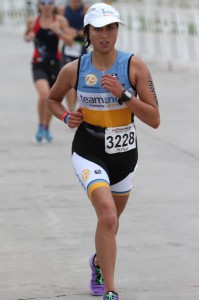 1) Training was no longer about my journey.
There were a lot of reasons I started running, but when it boiled down to it, I enjoyed my warm-up laps around the YMCA indoor track more than I enjoyed the rest of my workouts back in my “gym-rat” days. Then, I realized that the only thing stopping me from running longer was my mindset. If I didn’t lift one day, I could spend my whole hour or hour and a half of gym time running! It wasn’t long before I moved the running game out of the gym. When I got my first running watch, I used it to track distance, but I didn’t care a bit about speed on those runs. It was wonderful. I was healthy and happy. As I began to focus more on race results, I would run faster with friends or one day a week when I did a speed workout, but the bulk of my runs were 2-3 minutes per mile slower than the pace I was racing at. I didn’t know that I wasn’t supposed to be able to race as fast as I did running as slow as I was. Then, when I got Strava, I actually started paying attention to pace on training runs which I had never done. I would upload a run and then look at it. “Did I actually run that slowly? So-and-so’s run today was so much faster than mine, and I know I race faster than her!” I became self-conscious and began pushing a faster pace on all of my runs. In less than two months, I damaged my gastroc so badly that I could barely walk. I pulled out of the GR marathon because I was so badly hurt. I didn’t learn my lesson. I took ten days off, did a few slow runs and was back at it. I hurt the gastroc again. I recovered. I began working with coach Mark Olson who immediately dialed back my mileage and pace, but I resented uploading slow workouts and would push the pace every time I could. My poor past lifestyle choices were adding up and a few months later, I fractured my inferior pubic ramus. And you know what? I kept uploading! I biked and swam my heart out and I was darn proud of throwing down some 13 hour weeks with a fractured pelvis. Throughout this experience, I didn’t think once about my own journey. It was all about the perceptions of others.
1) Training was no longer about my journey.
There were a lot of reasons I started running, but when it boiled down to it, I enjoyed my warm-up laps around the YMCA indoor track more than I enjoyed the rest of my workouts back in my “gym-rat” days. Then, I realized that the only thing stopping me from running longer was my mindset. If I didn’t lift one day, I could spend my whole hour or hour and a half of gym time running! It wasn’t long before I moved the running game out of the gym. When I got my first running watch, I used it to track distance, but I didn’t care a bit about speed on those runs. It was wonderful. I was healthy and happy. As I began to focus more on race results, I would run faster with friends or one day a week when I did a speed workout, but the bulk of my runs were 2-3 minutes per mile slower than the pace I was racing at. I didn’t know that I wasn’t supposed to be able to race as fast as I did running as slow as I was. Then, when I got Strava, I actually started paying attention to pace on training runs which I had never done. I would upload a run and then look at it. “Did I actually run that slowly? So-and-so’s run today was so much faster than mine, and I know I race faster than her!” I became self-conscious and began pushing a faster pace on all of my runs. In less than two months, I damaged my gastroc so badly that I could barely walk. I pulled out of the GR marathon because I was so badly hurt. I didn’t learn my lesson. I took ten days off, did a few slow runs and was back at it. I hurt the gastroc again. I recovered. I began working with coach Mark Olson who immediately dialed back my mileage and pace, but I resented uploading slow workouts and would push the pace every time I could. My poor past lifestyle choices were adding up and a few months later, I fractured my inferior pubic ramus. And you know what? I kept uploading! I biked and swam my heart out and I was darn proud of throwing down some 13 hour weeks with a fractured pelvis. Throughout this experience, I didn’t think once about my own journey. It was all about the perceptions of others.
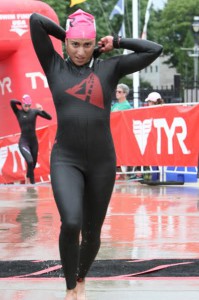 2) Training became a competition.
It’s ok to go to the track with a friend and challenge each other during a grueling workout. It is NOT ok to stalk them online when they are following a completely different training regime than you are and compare yourself to them! I was jealous of people doing speed work when I was recovering from my injury. I was angry when people I knew I was capable of beating in races uploaded “base” runs that were faster than mine. It wasn’t until I drew myself away from the social network that I remembered the Brad Paisley song I loved back in my days of cowboy boots and country music: “So Much Cooler Online.” How do I know that the “base” run was actually base? Who knows, that person could have had a heart rate of 180 the whole time. It doesn’t matter who has a “better” training run, it only matters who has a better race.
Adding to that, the whole MSU Triathlon Strava group that I was so psyched to be a part of? Well, it turns out, Strava tallies up placings every week. Placings are based off of training time alone. So, if I sit on my bicycle at a heartrate of 100 for 3 hours, I’m ranked higher than if I do intense intervals for 1 hour. That’s not the only problem though. Only swims, bikes and runs are tallied. This shouldn’t be an issue, but for competitive people with an extremely addictive nature (I’m describing myself, not accusing anyone), it’s really hard to suck up taking a second place when you know that if you would have spent those three very beneficial off-season weight lifting sessions biking, you would have “won.” I’m laughing as I write this, it sounds so silly when now that I am removed from it. But, when I was wrapped up in the middle, even though I knew it was wrong, it still affected me. There’s a very real danger in seeing training as competition. It’s training for a reason.
3) Training became about accolades.
For you non-Strava users, here’s how it works: you follow people, much like on Instagram or Twitter. You upload your workouts and you get a newsfeed of the workouts of everyone who you follow. Instead of favoriting something, as you would on Twitter, you give kudos. So, you spend the last mile of your run thinking up creative titles for your workouts or making excuses for why it wasn’t stellar. As an example, some of my workout titles include: “Killed my average by riding 4 miles of deep gravel on the tri bike,” “Sighting practice on 2 hrs of sleep,” “Don’t judge unless you rode in this wind!” What’s the theme? Excuses. And I don’t need to justify my workouts to anyone, because frankly, it’s no one’s business besides mine, and my coach’s. Then there were the snarky titles: “Thanks for the memories” – sounds like it’s just the song I was listening to, right? Well, sorta. I was listening to Fallout Boy. It was also a pot-shot at a fellow Strava-er that I was annoyed with. At the end of the day, though, it doesn’t matter how many kudos you got on Strava. What matters is what your body, mind, and spirit got from your training.
4) I was as focused on other’s workouts as much as my own.
This is a bad one. It goes back to embracing that every athlete is different. Everyone has a different life as well. Over the summer, I worked 24 hours straight sometimes at a demanding internship in an equine hospital. Truth be told, I love veterinary emergency work and I understand how important it is for my future career for me to get experience now. It is completely unfair to focus on how pristine other people’s training schedules are when they are living a completely different life. Breaking down their workouts does nothing to enhance my training. All it does is waste precious time and emotional energy.
2) Training became a competition.
It’s ok to go to the track with a friend and challenge each other during a grueling workout. It is NOT ok to stalk them online when they are following a completely different training regime than you are and compare yourself to them! I was jealous of people doing speed work when I was recovering from my injury. I was angry when people I knew I was capable of beating in races uploaded “base” runs that were faster than mine. It wasn’t until I drew myself away from the social network that I remembered the Brad Paisley song I loved back in my days of cowboy boots and country music: “So Much Cooler Online.” How do I know that the “base” run was actually base? Who knows, that person could have had a heart rate of 180 the whole time. It doesn’t matter who has a “better” training run, it only matters who has a better race.
Adding to that, the whole MSU Triathlon Strava group that I was so psyched to be a part of? Well, it turns out, Strava tallies up placings every week. Placings are based off of training time alone. So, if I sit on my bicycle at a heartrate of 100 for 3 hours, I’m ranked higher than if I do intense intervals for 1 hour. That’s not the only problem though. Only swims, bikes and runs are tallied. This shouldn’t be an issue, but for competitive people with an extremely addictive nature (I’m describing myself, not accusing anyone), it’s really hard to suck up taking a second place when you know that if you would have spent those three very beneficial off-season weight lifting sessions biking, you would have “won.” I’m laughing as I write this, it sounds so silly when now that I am removed from it. But, when I was wrapped up in the middle, even though I knew it was wrong, it still affected me. There’s a very real danger in seeing training as competition. It’s training for a reason.
3) Training became about accolades.
For you non-Strava users, here’s how it works: you follow people, much like on Instagram or Twitter. You upload your workouts and you get a newsfeed of the workouts of everyone who you follow. Instead of favoriting something, as you would on Twitter, you give kudos. So, you spend the last mile of your run thinking up creative titles for your workouts or making excuses for why it wasn’t stellar. As an example, some of my workout titles include: “Killed my average by riding 4 miles of deep gravel on the tri bike,” “Sighting practice on 2 hrs of sleep,” “Don’t judge unless you rode in this wind!” What’s the theme? Excuses. And I don’t need to justify my workouts to anyone, because frankly, it’s no one’s business besides mine, and my coach’s. Then there were the snarky titles: “Thanks for the memories” – sounds like it’s just the song I was listening to, right? Well, sorta. I was listening to Fallout Boy. It was also a pot-shot at a fellow Strava-er that I was annoyed with. At the end of the day, though, it doesn’t matter how many kudos you got on Strava. What matters is what your body, mind, and spirit got from your training.
4) I was as focused on other’s workouts as much as my own.
This is a bad one. It goes back to embracing that every athlete is different. Everyone has a different life as well. Over the summer, I worked 24 hours straight sometimes at a demanding internship in an equine hospital. Truth be told, I love veterinary emergency work and I understand how important it is for my future career for me to get experience now. It is completely unfair to focus on how pristine other people’s training schedules are when they are living a completely different life. Breaking down their workouts does nothing to enhance my training. All it does is waste precious time and emotional energy.
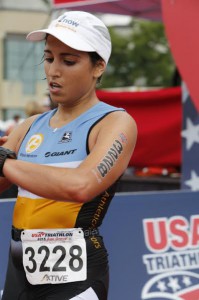 5) Strava became king
You know that there is a problem when you are stressed out because you don’t have internet access and you can’t upload a workout right away. Trust me. It’s okay. Your body knows that you had a breakthrough long ride! There is a saying in the world of Strava users: “Strava or it didn’t happen.” I think it’s meant as a joke, but the mentality is completely wrong. Your body doesn’t need Strava to recognize that you trained. When you have a melt down because your watch “ate” your run and you now can’t upload it, that may be a sign that there is a problem.
I’ve now been Strava-free for weeks and I couldn’t feel better about the decision. It was hard to pull the plug on it, but now I’m so glad I did. The stress about how my average in the pool or on the bike is going to look if I take a bit more rest so I can go harder on the intervals is gone. I’m not stressing about how much or little everyone else is training. My training is, once again, about my own journey. And that’s how I feel it should be for me. If you use Strava and it works for you, I’d love to hear your thoughts and stories. I know many people love using it to stay accountable and that’s great. However, if you start to experience any of the above-mentioned symptoms, I encourage you to search yourself to evaluate if your relationship with training-related social media is healthy for you. If it is, great! It if isn’t, maybe it’s time for a little purge.
Happy training if you’re in your offseason. Happy racing if you are a star Nordic skier like some of my teammates and this is your season!
The post Tough Training Lessons from Strava appeared first on Team Athletic Mentors.
5) Strava became king
You know that there is a problem when you are stressed out because you don’t have internet access and you can’t upload a workout right away. Trust me. It’s okay. Your body knows that you had a breakthrough long ride! There is a saying in the world of Strava users: “Strava or it didn’t happen.” I think it’s meant as a joke, but the mentality is completely wrong. Your body doesn’t need Strava to recognize that you trained. When you have a melt down because your watch “ate” your run and you now can’t upload it, that may be a sign that there is a problem.
I’ve now been Strava-free for weeks and I couldn’t feel better about the decision. It was hard to pull the plug on it, but now I’m so glad I did. The stress about how my average in the pool or on the bike is going to look if I take a bit more rest so I can go harder on the intervals is gone. I’m not stressing about how much or little everyone else is training. My training is, once again, about my own journey. And that’s how I feel it should be for me. If you use Strava and it works for you, I’d love to hear your thoughts and stories. I know many people love using it to stay accountable and that’s great. However, if you start to experience any of the above-mentioned symptoms, I encourage you to search yourself to evaluate if your relationship with training-related social media is healthy for you. If it is, great! It if isn’t, maybe it’s time for a little purge.
Happy training if you’re in your offseason. Happy racing if you are a star Nordic skier like some of my teammates and this is your season!
The post Tough Training Lessons from Strava appeared first on Team Athletic Mentors. 



 Our Hockey Site
Our Hockey Site Team AM
Team AM


